How We Can Help
We provide free tick identification via email photo (Pesthelp@santacruzcountyca.gov) or sample drop-off to our office at 640 Capitola Rd, Santa Cruz, 95062. For the fastest response, use email.
After identifying your tick’s species, we will provide free information on tick borne disease transmission risk, Lyme Disease Testing, habitat management, and tick removal & avoidance best practices.
We conduct tick surveillance throughout Santa Cruz County to monitor tick populations for species, abundance, and Lyme disease prevalence. Known as tick flagging, ticks are collected by dragging a cloth “flag” along the edges of trails and checked every few yards for adults and nymphs.
We post warning signs in areas where we find ticks.
 Historical Tick Collection Sites
Historical Tick Collection Sites
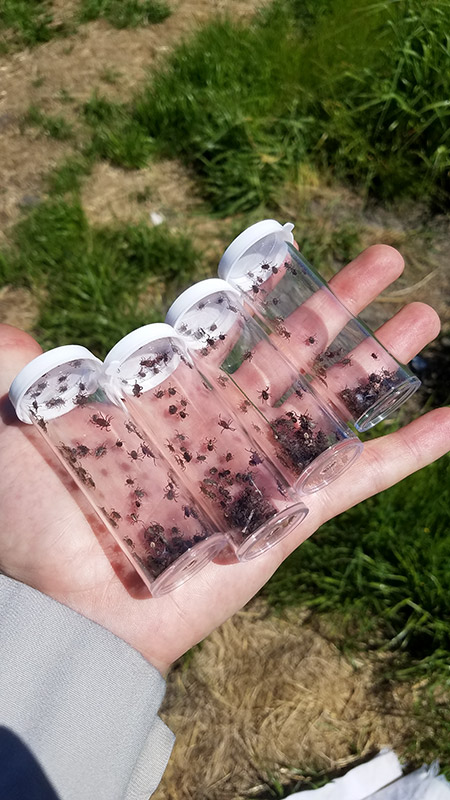 Ticks flagged and collected after 1.5 hrs. near the West Branch of Struve Slough
Ticks flagged and collected after 1.5 hrs. near the West Branch of Struve Slough
There are two main types of ticks: soft-bodied (argasids) and hard-bodied (ixodids). Soft ticks are normally associated with burrows or other microhabitats frequented by their primary vertebrate hosts like rodents. These ticks thrive in hot and dry environments and are most found in the western United States. They tend to live in dens, caves, and animal burrows, as well as broken down human dwellings like beneath floorboards or between walls.
Though it is not impossible, you’re not likely to encounter soft ticks in natural vegetation. Humans typically encounter soft ticks in rustic cabins. The ticks emerge at night and feed briefly while people are sleeping. Most people are unaware that they have been bitten.
When compared to hard ticks, soft ticks feed on their hosts quickly, detach, and come back later to feed again. Because of this, they can transmit disease in 15 minutes or less. They tend to search for food at night. They can transmit Borrelia hermsii that can cause Tick Borne Relapsing Fever (TBRF). In California, only about 1-8 cases of TBRF are reported each year.
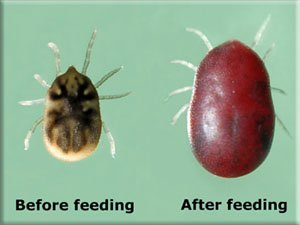 O. hermsi tick, before and after feeding. Photo taken by Gary Hettrick RML, NIAID.
O. hermsi tick, before and after feeding. Photo taken by Gary Hettrick RML, NIAID.
Hard ticks (Ixodidae) are what most people think of when they are referring to ticks. These have a hard outer shield or scutum on their backs below their heads. The scutum covers the entire body of a male tick while females have a half scutum with a softer lower abdomen that allows the tick to engorge with blood while feeding, growing to sizes multiple magnitudes larger than unfed.
Slightly over 90% of hard-tick species undergo a three-host life cycle in which the larva, nymph, and adult each feed on a different vertebrate belonging to the same or two to three different species. The remaining species exhibit either a two- or one-host life cycle. Following attachment, most hard ticks require several days to a week or longer to feed to repletion with rapid engorgement occurring late during the feeding process. Immatures and adults feed only once, but under unusual circumstances, hard ticks may take a partial blood meal from one host and reattach to another host.
In the United States, ticks are known to transmit 14 human pathogens, including nine bacteria (Borrelia burgdorferi, Borrelia hermsii, Borrelia parkeri, Borrelia turicatae, Coxiella burnetii, Ehrlichia chaffeensis,
Ehrlichia sp., Francisella tularensis, and Rickettsia rickettsii), two viruses (Colorado tick fever virus, Powassan encephalitis virus), and three single-celled protozoans (Babesia microti, Babesia sp., Babesia sp. near divergens)
The common ticks found in Santa Cruz County are the Western blacklegged tick (Ixodes pacificus), the Pacific Coast tick (Dermacentor occidentalis), and the American dog tick (Dermacentor variabilis). The Western blacklegged tick can spread Lyme diseases and anaplasmosis, the Pacific Coast tick can spread spotted fever, and tularemia, and the dog tick can spread spotted fever.
Lyme Disease
Borrelia burgdorferi is the type of bacteria that can cause Lyme Disease and is the most common of the tick-borne illnesses. As a bacteria, it lives in the midgut of an Ixodes pacificus female tick until feeding. After 18-24 hours of attachment and feeding, the bacteria moves into the ticks salivary glands where it can transmit to the host. Ticks become infected after feeding on infected small mammals like rodents and lagomorphs (rabbits), often their first blood meal, that are the reservoirs of Borrelia burgdorferi in nature.
Both nymphs and adults of the western blacklegged tick can transmit the infection to humans. Nymphs likely play a greater role in transmission of Lyme disease to humans because they are small (<1mm or about the size of a poppy seed) and thus are difficult to see. Also, in some areas of California, a higher percentage of nymphal ticks carry the Lyme disease organism than adult ticks. Larval tick are not often encountered by humans in nature as they live in or near animal burrows and nests.
Studies have shown that one of the nymphal Ixodes pacficius’ favorite hosts to feed on is the Western Fence lizard, commonly known as a blue-belly lizard. These reptiles have compounds in their blood which work to destroy the Borrelia bugdorferi bacteria and surveys have shown multiple magnitudes less in adult Western Blacklegged ticks than in nymphs. Essentially, when a nymphal ticks feed on a Western Fence lizard it inoculates itself against Borrelia bugdorferi and is no longer a carrier.
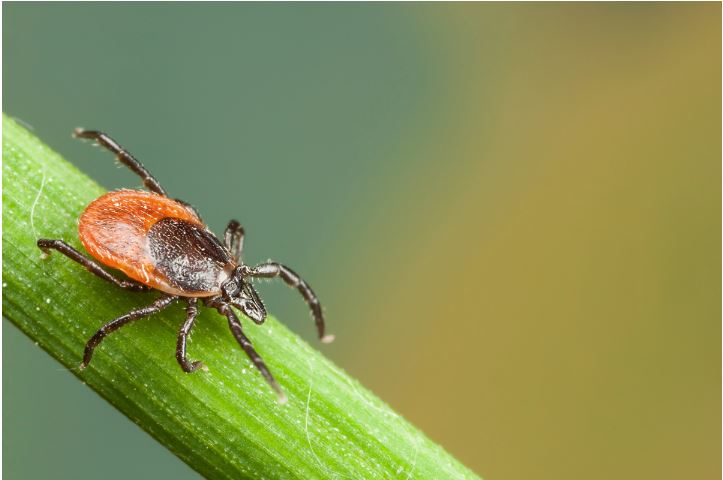 Ixodes scapularis, aka the black-legged tick or deer tick. Source: CDC
Ixodes scapularis, aka the black-legged tick or deer tick. Source: CDC
Tick Life Cycle
Hard ticks have four distinct forms: egg, larvae, nymph, and adult. Most ticks of public health importance have a three-host life cycle.
Three-host ixodid ticks have a life cycle that usually spans three years, although some species can complete the cycle in only two years. Adult females drop off the third host to lay eggs after feeding (1), usually in the fall. Eggs hatch into six-legged larvae (2) and overwinter in the larval stage. In the spring, the larvae seek out and attach to the first host, usually a small rodent (3). Later in the summer, engorged larvae leave the first host (4) and molt into nymphs (5), usually in the fall. The ticks overwinter in this stage. During the following spring, the nymphs seek out and attach to the second host (6), usually another rodent. The nymphs feed on the second host and drop off later in the summer (7). Nymphs molt into adults (7a) – (7b) off the host in the late summer or fall and overwinter in this stage. The next spring, adults seek out and attach to a third host, which is usually a larger herbivore, carnivore, or human (8). The adults feed and mate on the third host during the summer. Females drop off the host in the fall to continue the cycle. Females may reattach and feed multiple times. The three hosts do not necessarily have to be different species, or even different individuals. Also, humans may serve as first, second or third hosts.
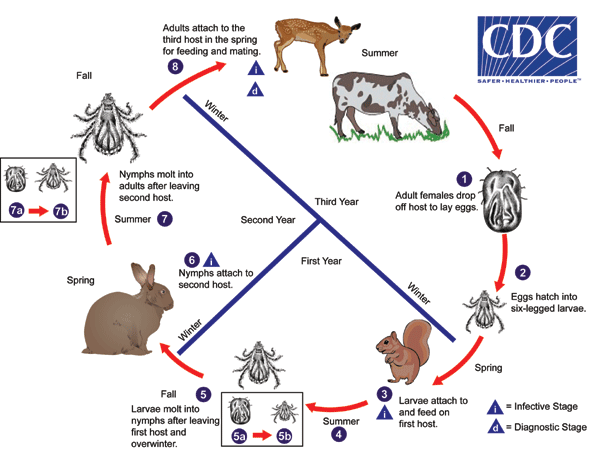 Three host cycle of an ixodid (hard) tick. Credit: CDC
Three host cycle of an ixodid (hard) tick. Credit: CDC
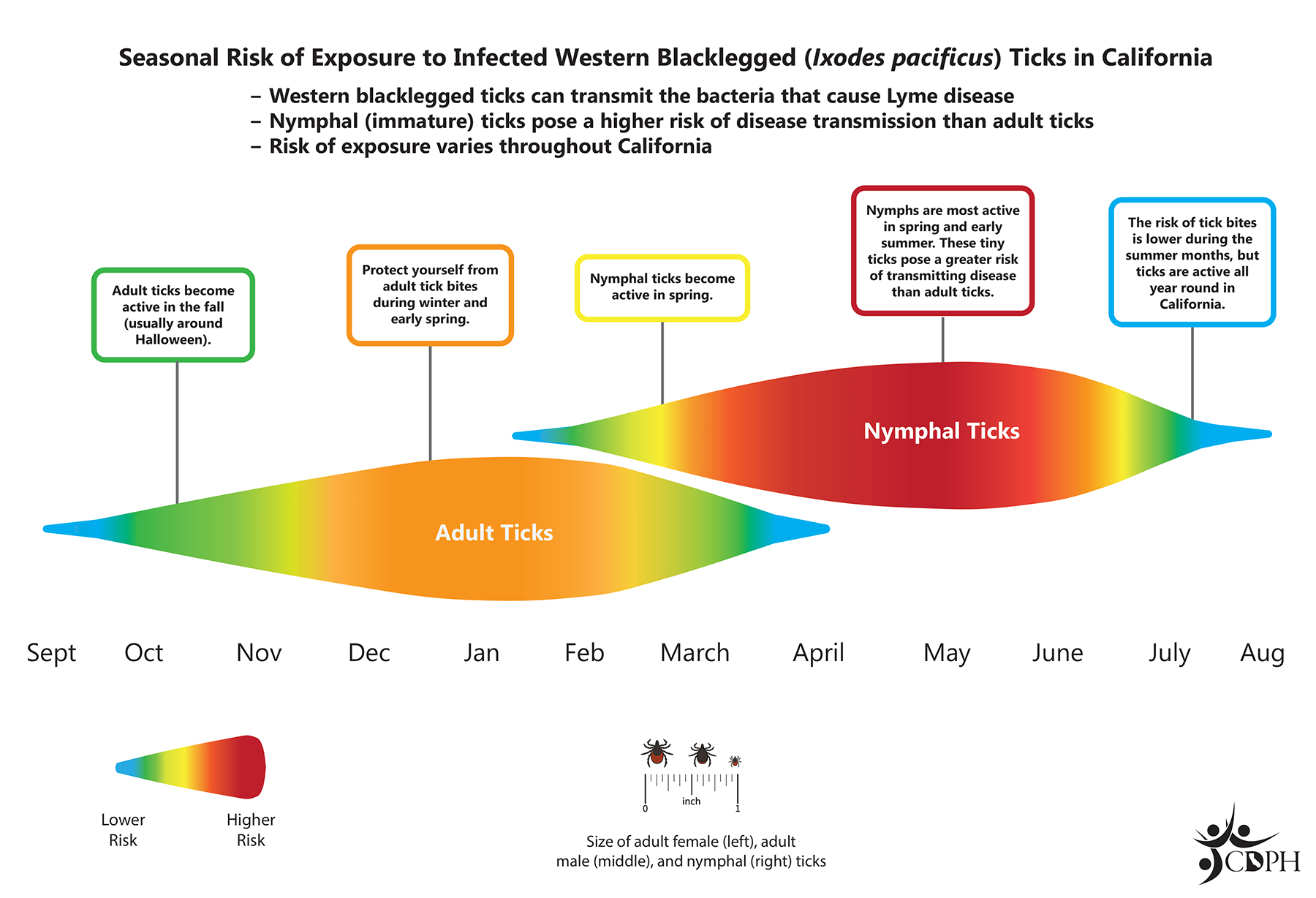 Credit: California Department of Public Health
Credit: California Department of Public Health
Tick Habitat
Adult hard ticks are often found on blades of grasses and weeds, clasping the vegetation with their lower legs and outstretching their first two legs, waiting for a host to brush by to grab onto.
Nymphal ticks are often found in leaf litter and logs on the ground. Nymphal ticks are much smaller than adults, about the size of a poppy seed, and are often missed when doing a tick check after being around their habitat. This, coupled with the higher rates of Borrelia burgdorferi, means nymphal ticks, rather than adults, are much more likely to transmit Lyme disease.
Tick Bite Prevention
Hard ticks are very susceptible to desiccation, and we can use this to our benefit. After being in suspected tick habitats, you can place your clothes and equipment in a dryer on high for 15 minutes which will dry out and kill the ticks. Hard ticks often do not attach right away and when they do attach, it may take some time to fully attach themselves down to the host using their serrated mouthparts and cement-like saliva. A quick shower and wipe-down will work great to remove any ticks that may be roaming around on the skin or just beginning to attach.
Repellents are a great tool to use before heading out into nature to prevent tick bites. Treating clothes beforehand with permethrin or treating the skin with DEET, IR3535, picaridin, or Oil of Lemon Eucalyptus are some of the best tick prevention methods the CDC recommends.
Tick Removal
- Use clean, fine-tipped tweezers.
- Grasp the tick as close to the skin’s surface as possible.
- Pull upward with steady, even pressure. Don’t twist or jerk the tick; this can cause the mouth-parts to break off and remain in the skin. If this happens, remove the mouth-parts with tweezers. If you cannot remove the mouth easily with tweezers, leave it alone and let the skin heal.
- After removing the tick, thoroughly clean the bite area and your hands with rubbing alcohol or soap and water.
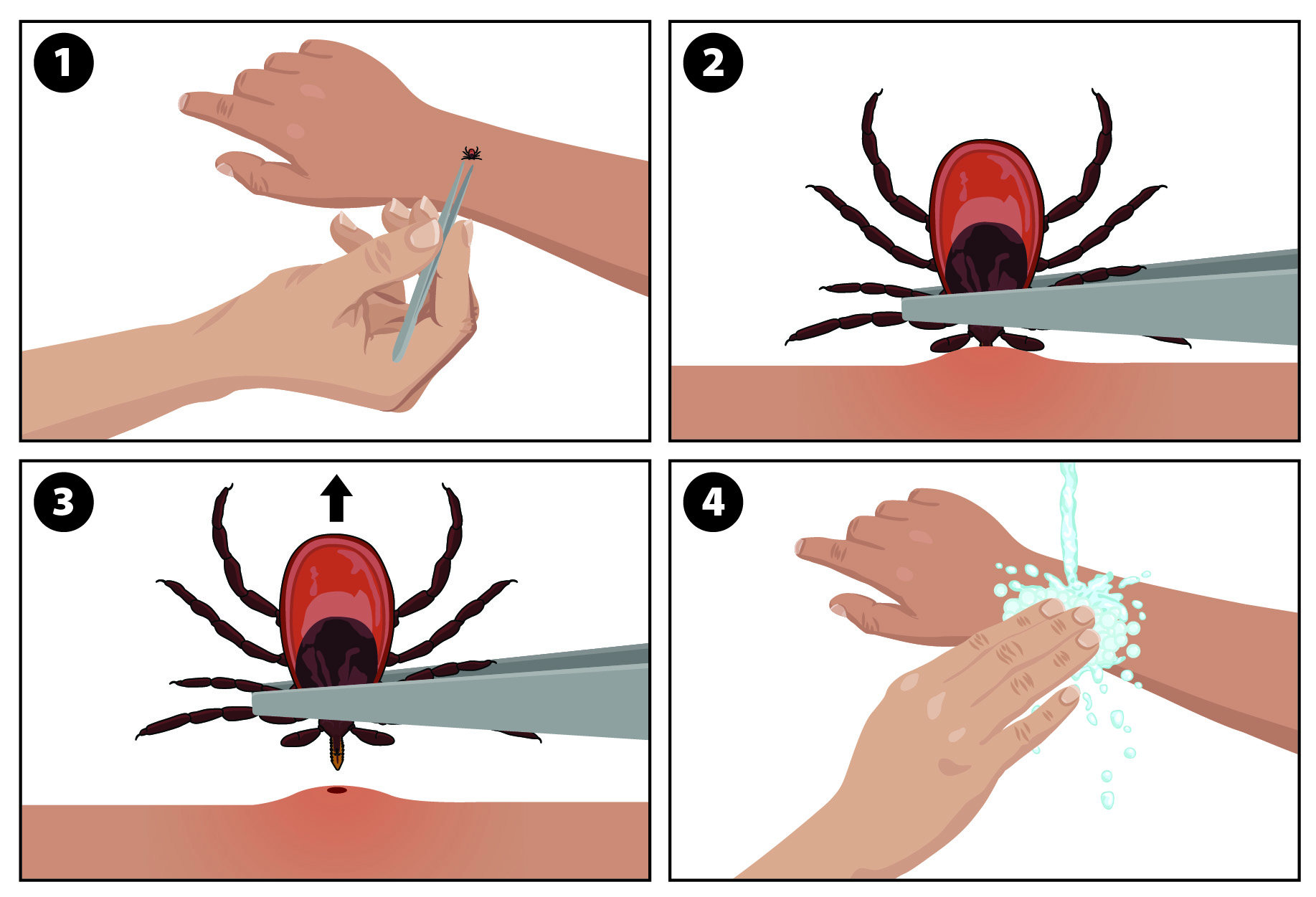 Credit: CDC
Credit: CDC
Never crush a tick with your fingers. Dispose of a live tick by:
- Putting it in alcohol.
- Placing it in a sealed bag/container.
- Wrapping it tightly in tape, or
- Flushing it down the toilet.
Additional Link and Webpages